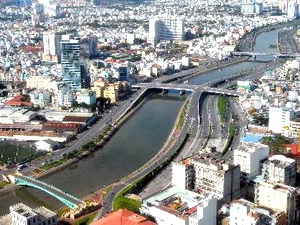HCMC approves socio-economic master plan
VGP – Ho Chi Minh City’s People’s Council has passed the master plan for socio-economic development through 2020, vision to 2025.
 |
The local economy is expected to expand 10-10.5% in the period of 2011-2015, 9.5-10% in the 2016-2020 period and 8.5-9% between 2021 and 2025. The GDP per capita will reach US$8,430-8,822 by 2020.
Its population will increase to 8.2 million by 2015 and 10 million in the following decade.
In 2016, HCMC will raise its poverty line to VND 16 million/person/year and poor households are about to account for 7-8% of the city’s total figure.
HCMC also targets to focus on developing priority fields: services, industry-construction, agriculture and rural development, culture-society, healthcare, culture and sports, science and technology, national defense and security, technical infrastructure, housing development and environmental protection.
The city expects to provide clean water supply to 98% people in rural areas and the figure will reach 100% by 2020./.
By Hai Minh

